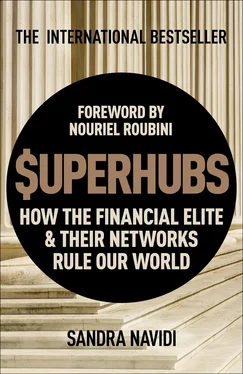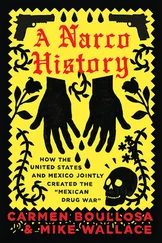Sandra Navidi - SuperHubs - How the Financial Elite and Their Networks Rule our World
Здесь есть возможность читать онлайн «Sandra Navidi - SuperHubs - How the Financial Elite and Their Networks Rule our World» весь текст электронной книги совершенно бесплатно (целиком полную версию без сокращений). В некоторых случаях можно слушать аудио, скачать через торрент в формате fb2 и присутствует краткое содержание. Год выпуска: 2017, Издательство: Hodder & Stoughton, Жанр: Старинная литература, на английском языке. Описание произведения, (предисловие) а так же отзывы посетителей доступны на портале библиотеки ЛибКат.
- Название:SuperHubs: How the Financial Elite and Their Networks Rule our World
- Автор:
- Издательство:Hodder & Stoughton
- Жанр:
- Год:2017
- ISBN:нет данных
- Рейтинг книги:4 / 5. Голосов: 1
-
Избранное:Добавить в избранное
- Отзывы:
-
Ваша оценка:
- 80
- 1
- 2
- 3
- 4
- 5
SuperHubs: How the Financial Elite and Their Networks Rule our World: краткое содержание, описание и аннотация
Предлагаем к чтению аннотацию, описание, краткое содержание или предисловие (зависит от того, что написал сам автор книги «SuperHubs: How the Financial Elite and Their Networks Rule our World»). Если вы не нашли необходимую информацию о книге — напишите в комментариях, мы постараемся отыскать её.
SuperHubs: How the Financial Elite and Their Networks Rule our World — читать онлайн бесплатно полную книгу (весь текст) целиком
Ниже представлен текст книги, разбитый по страницам. Система сохранения места последней прочитанной страницы, позволяет с удобством читать онлайн бесплатно книгу «SuperHubs: How the Financial Elite and Their Networks Rule our World», без необходимости каждый раз заново искать на чём Вы остановились. Поставьте закладку, и сможете в любой момент перейти на страницу, на которой закончили чтение.
Интервал:
Закладка:
13. Alec Hogg, “As Inequality Soars, the Nervous Super Rich Are Already Planning Their Escapes,” The Guardian, January 23, 2015, http://www.theguardian.com/public-leaders-network/2015/jan/23/nervous-super-rich-planning-escapes-davos-2015.
CHAPTER 2
1. Michael T. Kaufman, Soros: The Life and Times of a Messianic Billionaire (New York: Vintage, 2010), Kindle Locations 1677-81, Kindle edition.
2. George Soros, The New Paradigm for Financial Markets: The Credit Crisis of 2008 and What It Means (New York: PublicAffairs, 2008), 102-105;
George Soros, “Soros: General Theory of Reflexivity,” Financial Times, October 27, 2009, http://www.ft.com/intl/cms/s/2/0ca06172-bfe9-11de-aed2-00144feab49a.xhtml.
3. George Soros, Soros on Soros: Staying Ahead of the Curve (New York: Wiley, 1995), Kindle locations 1200-1204, Kindle edition.
4. For reference, see also: Taleb, The Black Swan, Kindle locations 4881-87.
5. Nicholas A. Christakis and James H. Fowler, Connected: The Surprising Power of Our Social Networks and How They Shape Our Lives (New York: Little, Brown and Company, 2009), 26, Kindle edition; Richard Koch and Greg Lockwood, Superconnect: Harnessing the Power of Networks and the Strength of Weak Links (New York: W. W. Norton, 2010), 13, Kindle edition; Duncan J. Watts, Six Degrees: The Science of a Connected Age (New York: W. W. Norton, 2004), Kindle location 599-670, Kindle edition.
6. Albert-Laszlo Barabasi and Jennifer Frangos, Linked: The New Science of Networks (New York: Basic Books, 2002), 106, Kindle edition.
7. Ibid., 221.
8. Koch and Lockwood, Superconnect, 184.
9. David Easley and Jon Kleinberg, Networks, Crowds, and Markets: Reasoning about a Highly Connected World (New York: Cambridge University Press, 2010), Kindle locations 11169-11252, Kindle edition; Barabasi and Frangos, Linked, 88; Koch and Lockwood, Superconnect, 184-185.
10. Barabasi and Frangos, Linked, 85.
11. Ibid., 87, 106; 85.
12. Meadows, Thinking in Systems, 17.
13. Watts, Six Degrees, Kindle location 318; Barabasi and Frangos, Linked, 110.
14. James Barron, “The Blackout of2003: The Overview; Power Surge Blacks Out Northeast, Hitting Cities in 8 States and Canada; Midday Shutdown Disrupts Millions,” New York Times, August 15, 2003.
15. Allen N. Berger, Thomas Kick, Michael Koetter, and Klaus Schaeck, “Does It Pay to Have Friends? Social Ties and Executive Appointments in Banking,” Journal of Banking & Finance 37(6) (June 2013): 2087-2105, http://www.frankfurt-school.de/clicnetclm/fileDownload.do?goid=000000411442AB4.
16. Nikhil Swaminathan, “For the Brain, Cash Is Good, Status Is Better,” Scientific American, April 24, 2008, http://www.scientificamerican.com/article.cfm?id=for-the-brain-status-is-better.
17. Sergey Gavrilets and Laura Fortunato, “The Altruistic Side of Aggressive Greed: Study Explains New Twist in Group Cooperation,” National Institute for Mathematical and Biological Synthesis, press release, March 26, 2014, https://www.sciencedaily.com/releases/2014/03/140326092600.htm.
18. Phil Rosenzweig, The Halo Effect:. . . And the Eight Other Business Delusions That Deceive Managers (New York: Free Press, 2007), Kindle locations 1074-77, Kindle edition.
19. For reference: Jeffrey Pfeffer, Power: Why Some People Have It—and Others Don’t (New York: HarperCollins, 2010), Kindle location 1782, Kindle edition.
20. Rob Cross, “The Most Valuable People in Your Network,” Harvard Business Review BlogNetwork, March 8, 2011, https://hbr.org/2011/03/the-most-valuable-people-in-yo.
21. Robin Dunbar, How Many Friends Does One Person Need? Dunbar’s Number and Other Evolutionary Quirks (Boston: Cambridge University Press, 2010), Kindle locations 40-42, Kindle edition; Drake Bennett, “The Dunbar Number: From the Guru of Social Networks,” Businessweek, January 10, 2013, http://www.businessweek.com/articles/2013-01-10/the-dunbar-number-from-the-guru-of-social-networks.
22. Valdis Krebs, “Power in Networks,” Orgnet.com , 2004, http://www.orgnet.com/PowerInNetworks.pdf.
23. John Field, Social Capital (London: Taylor and Francis, 2008), Kindle locations 1552-53, Kindle edition.
24. Elizabeth Bernstein, “The Friendship Bank: How and Why Even the Most Giving Friend Expects Payback,” Wall Street Journal, Sept. 23, 2013, http://online.wsj.com/news/articles/SB10001424052702304713704579093141120660698.
25. Matthew D. Lieberman, Social: Why Our Brains Are Wired to Connect (New York: Crown, 2013), Kindle locations 3711-16, Kindle edition.
CHAPTER 3
1. Michael McLeay, Amar Radia and Ryland Thomas, “Money Creation in the Modern Economy,” Quarterly Bulletin, Bank of England, 2014.
2. For reference, see also: Ralph Atkins, “Central Banks Shift into Shares as Low Rates Hit Revenues,” Financial Times, June 15, 2014, https://next.ft.com/content/d9dfad02-f462-11e3-a143-00144feabdc0.
3. David Wessel, In FED We Trust: Ben Bernanke’s War on the Great Panic (New York: Random House, 2009), 129, Kindle edition; Ben S. Bernanke, “Modern Risk Management and Banking Supervision,” speech delivered at the Stonier Graduate School of Banking, Washington, D.C., June 12, 2006, http://www.federalreserve.gov/newsevents/speech/Bernanke20060612a.htm.
4. Pedro Nicolaci da Costa, “Fed Missed Crisis Due to Narrow Mindset, Says Study,” Wall Street Journal, March 7, 2014, http://blogs.wsj.com/economics/2014/03/07/fed-missed-crisis-due-to-narrow-mindset-says-study.
5. Bob Ivry, Bradley Keoun and Phil Kuntz, “Secret Fed Loans Gave Banks $13 Billion Undisclosed to Congress,” Bloomberg, Nov. 27, 2011, http://www.bloomberg.com/news/2011-11-28/secret-fed-loans-undisclosed-to-congress-gave-banks-13-billion-in-income.xhtml.
6. Emma Coleman Jordan, “The Federal Reserve and a Cascade of Failures: Inequality, Cognitive Narrrowness and Financial Network Theory,” Georgetown University Law Center, Faculty Research Workshop, April 17, 2014; Peter Coy, “Bernanke, the Reluctant Revolutionary,” Businessweek, August 1, 2012, http://www.bloomberg.com/news/articles/2012-08-01/bernanke-the-reluctant-revolutionary.
7. Andrew Ross Sorkin, “What Timothy Geithner Really Thinks,” New York Times, May 8, 2014, http://www.nytimes.com/2014/05/11/magazine/what-timothy-geithner-really-thinks.xhtml.
8. Wessel, In FED We Trust, 209.
9. Adam LeBor, Tower of Basel: The Shadowy History of the Secret Bank that Runs the World (New York: PublicAffairs, 2013), Kindle edition.
10. For reference see: Liaquat Ahamed, Lords of Finance: The Bankers Who Broke the World (New York: Penguin, 2009), Kindle edition.
11. “About the IMF,” The International Monetary Fund, http://www.imf.org/external/about.htm.
12. James Gleick, The Information: A History, a Theory, a Flood (New York: Random House, 2011), 9, Kindle edition.
13. Meadows, Thinking in Systems, 14.
14. Manuel Castells, The Rise of the Network Society: The Information Age: Economy, Society, and Culture Volume I (Hoboken, NJ: Wiley-Blackwell, 2011), Kindle locations 569-71, Kindle edition.
15. Steven Kotler and Peter H. Diamandis, Abundance: The Future Is Better Than You Think (New York: Simon & Schuster, 2012), Kindle locations 3695-96, Kindle edition.
16. Erik Holm and Anupreeta Das, “Buffett Reminds His Top Managers: Reputation Is Everything,” Wall Street Journal, December 19, 2014, http://blogs.wsj.com/moneybeat/2014/12/19/buffett-reminds-his-top-managers-reputation-is-everything.
Читать дальшеИнтервал:
Закладка:
Похожие книги на «SuperHubs: How the Financial Elite and Their Networks Rule our World»
Представляем Вашему вниманию похожие книги на «SuperHubs: How the Financial Elite and Their Networks Rule our World» списком для выбора. Мы отобрали схожую по названию и смыслу литературу в надежде предоставить читателям больше вариантов отыскать новые, интересные, ещё непрочитанные произведения.
Обсуждение, отзывы о книге «SuperHubs: How the Financial Elite and Their Networks Rule our World» и просто собственные мнения читателей. Оставьте ваши комментарии, напишите, что Вы думаете о произведении, его смысле или главных героях. Укажите что конкретно понравилось, а что нет, и почему Вы так считаете.












